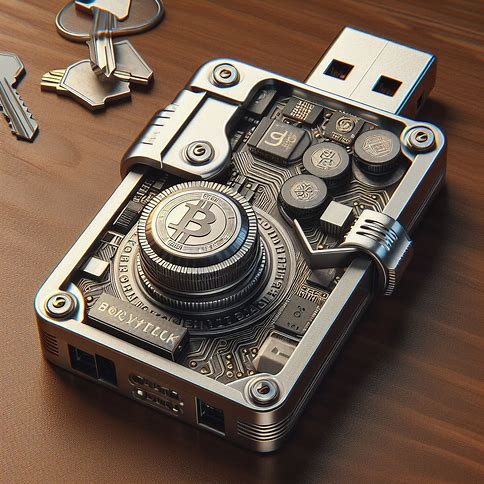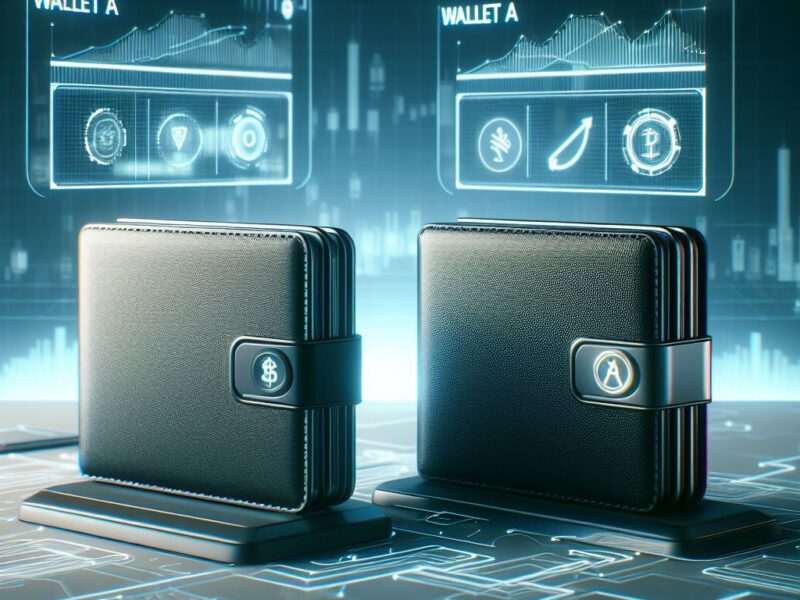When it comes to safeguarding cryptocurrencies, hardware wallets are the most reliable. These physical devices are designed specifically for storing digital assets offline. They offer a level of protection that software wallets simply can’t match. If you’re serious about holding onto your crypto for a long time, below are some of the best hardware wallets to entrust your crypto.
1. Ledger Nano X
The Ledger Nano X is a popular choice among cryptocurrency enthusiasts, and for good reason. This sleek, compact device packs a powerful punch when it comes to security and functionality. The Nano X has a secure element chip, which provides an extra layer of protection against physical tampering and hacking attempts.
One of the standout features of the Ledger Nano X is its Bluetooth connectivity. This allows users to manage their cryptocurrencies on the go, using the Ledger Live mobile app. The device supports over 1,500 digital assets, making it a versatile choice for those with diverse portfolios.
The Nano X’s user interface is intuitive and easy to navigate, thanks to its large, high-contrast display and two buttons for confirming transactions. The device also features a built-in rechargeable battery, which allows for longer usage periods and greater portability compared to its predecessor, the Ledger Nano S.
Setting up the Ledger Nano X is a straightforward process, with clear instructions provided in the box and through the Ledger Live software. Users are guided through the initialization process, which includes setting up a PIN code and a recovery phrase. It’s crucial to keep your recovery phrase safe and secure, as it’s the only way to restore your wallet if your device is lost, stolen, or damaged.
In terms of build quality, the Ledger Nano X feels solid and durable. Its stainless steel casing and plastic buttons are designed to withstand everyday wear and tear, ensuring your device remains functional and secure for years to come.
While the Ledger Nano X is priced higher than some other hardware wallets on the market, its advanced features, extensive cryptocurrency support, and reputation for security make it a worthwhile investment for serious crypto holders.
Key features of the Ledger Nano X:
– Secure element chip for enhanced protection
– Bluetooth connectivity for mobile management
– Supports over 1,500 digital assets
– Intuitive user interface with a large display
– Built-in rechargeable battery for portability
– Solid build quality with a stainless steel casing
2. Trezor Model T
The Trezor Model T, created by SatoshiLabs, is another top contender in the hardware wallet market. This device boasts a host of advanced features and a user-friendly interface, making it an excellent choice for both novice and experienced crypto users.
One of the most notable features of the Trezor Model T is its full-color touchscreen display. This makes navigating the device’s interface and confirming transactions a breeze. The touchscreen also eliminates the need for physical buttons, which can wear out over time.
The Model T supports over 1,000 cryptocurrencies, including major assets like Bitcoin, Ethereum, and Litecoin, as well as a wide range of ERC-20 tokens. This extensive support ensures that users can store and manage a diverse array of digital assets on a single device.
Security is a top priority for the Trezor Model T. The device features a secure element chip, similar to the Ledger Nano X, which provides an additional layer of protection against physical tampering and hacking attempts. The Model T also employs a randomized keypad for PIN entry, which helps prevent keyloggers and other forms of malware from stealing your PIN.
Setting up the Trezor Model T is a simple process, with the device guiding users through the initialization steps via its touchscreen display. Users are prompted to set up a PIN code and generate a recovery seed, which is crucial for restoring your wallet in case of loss or damage.
One unique feature of the Trezor Model T is its compatibility with the open-source Trezor Suite software. This allows users to manage their cryptocurrencies, view transaction history, and even buy and exchange digital assets directly from the device.
Key features of the Trezor Model T:
– Full-color touchscreen display for easy navigation
– Supports over 1,000 cryptocurrencies and tokens
– Secure element chip for enhanced protection
– Randomized keypad for PIN entry to prevent malware
– Compatibility with the open-source Trezor Suite software
– User-friendly interface for novice and experienced users
3. KeepKey
KeepKey is a sleek and simple hardware wallet that prioritizes security and ease of use. This device is an excellent choice for those who want a straightforward, no-frills solution for storing their cryptocurrencies long-term.
One of the first things you’ll notice about the KeepKey is its large, premium-feel aluminum case. This durable construction not only looks great but also provides a high level of physical protection for the device’s internal components. The KeepKey’s large OLED display is another standout feature, making it easy to read wallet addresses and confirm transactions.
Related: Advantages And Disadvantages Of Hardware Wallets
While the KeepKey may not support as many cryptocurrencies as some other hardware wallets (it currently supports around 40 digital assets), it does cover the most popular ones, such as Bitcoin, Ethereum, Litecoin, and Dash. This focused support makes the KeepKey an ideal choice for users who primarily hold these major cryptocurrencies.
Setting up the KeepKey is a breeze, thanks to its integration with the ShapeShift platform. Users can initialize their device and manage their cryptocurrencies using the ShapeShift web interface, which provides a user-friendly experience for buying, selling, and exchanging digital assets.
Security-wise, the KeepKey employs a secure element chip and a PIN code system to protect your cryptocurrencies. The device also generates a 12-word recovery phrase during setup, which is essential for restoring your wallet if your KeepKey is lost, stolen, or damaged.
One unique feature of the KeepKey is its ability to function as a U2F (Universal 2nd Factor) authentication device. This means you can use your KeepKey to secure your online accounts with two-factor authentication, adding an extra layer of protection beyond just your cryptocurrencies.
Key features of the KeepKey:
– Large, durable aluminum case for physical protection
– Easy-to-read OLED display for confirming transactions
– Supports major cryptocurrencies like Bitcoin, Ethereum, and Litecoin
– Integration with ShapeShift for easy management and exchange
– Secure element chip and PIN code system for security
– U2F authentication capabilities for online account protection
4. CoolWallet S
The CoolWallet S is a unique hardware wallet that stands out from the crowd due to its slim, credit card-sized design. This ultra-portable device is perfect for users who want to keep their cryptocurrencies secure while on the move.
Despite its compact size, the CoolWallet S packs a punch when it comes to features and security. The device boasts a secure element chip, which provides tamper-resistant protection for your private keys. It also utilizes Bluetooth technology to pair with your smartphone, allowing you to manage your cryptocurrencies using the CoolBitX app.
The CoolWallet S supports a range of popular cryptocurrencies, including Bitcoin, Ethereum, Litecoin, Ripple, and several ERC-20 tokens. While its supported assets may not be as extensive as some other hardware wallets, the CoolWallet S covers the most widely-held cryptocurrencies.
One of the standout features of the CoolWallet S is its ability to function as a cold storage device while still offering the convenience of a mobile wallet. When not in use, the device remains offline, keeping your private keys secure. When you need to make a transaction, simply pair the CoolWallet S with your smartphone via Bluetooth and use the CoolBitX app to manage your funds.
Setting up the CoolWallet S is a straightforward process, with the CoolBitX app guiding users through the initialization steps. The app also provides a user-friendly interface for managing your cryptocurrencies, viewing transaction history, and adjusting settings.
The CoolWallet S’s card-like design makes it incredibly easy to carry around, as it can fit seamlessly into your wallet alongside your regular credit cards. This portability, combined with its strong security features, makes the CoolWallet S an excellent choice for users who frequently travel or want to keep their hardware wallet with them at all times.
Key features of the CoolWallet S:
– Slim, credit card-sized design for ultimate portability
– Secure element chip for tamper-resistant protection
– Bluetooth connectivity for mobile management via the CoolBitX app
– Supports popular cryptocurrencies like Bitcoin, Ethereum, and Litecoin
– Cold storage functionality with the convenience of a mobile wallet
– User-friendly setup and management through the CoolBitX app
5. BitBox02
The BitBox02, created by the Swiss company Shift Crypto, is a hardware wallet that combines strong security features with a user-friendly interface. This device is an excellent choice for users who value privacy, reliability, and ease of use.
One of the standout features of the BitBox02 is its dual-chip design. The device employs both a secure element chip and a general-purpose chip, which work together to provide an extra layer of security. This unique architecture ensures that your private keys remain protected even if one of the chips is compromised.
The BitBox02 supports a range of popular cryptocurrencies, including Bitcoin, Ethereum, Litecoin, and ERC-20 tokens. While its supported assets may not be as extensive as some other hardware wallets, the BitBox02 covers the most widely-held cryptocurrencies, making it suitable for most users’ needs.
Setting up the BitBox02 is a simple and intuitive process, thanks to its integration with the BitBoxApp. This desktop application guides users through the initialization process, which includes setting up a device password and generating a 24-word recovery phrase. The BitBoxApp also provides a user-friendly interface for managing your cryptocurrencies, viewing transaction history, and adjusting device settings.
One unique feature of the BitBox02 is its touch sensors, which replace traditional buttons. These sensors allow users to navigate the device’s interface and confirm transactions by simply tapping or swiping, providing a more intuitive and responsive user experience.
Privacy is a key focus for the BitBox02. The device includes a range of privacy-enhancing features, such as a true random number generator (TRNG) for generating secure private keys and the ability to connect to your own full node for added security and privacy.
The BitBox02’s compact, minimalist design makes it easy to carry around discreetly, while its durable aluminum case provides excellent protection against physical damage. The device also features a micro SD card slot, which allows users to create an offline backup of their recovery phrase for added security.
Key features of the BitBox02:
– Dual-chip design with a secure element and general-purpose chip for enhanced security
– Supports popular cryptocurrencies like Bitcoin, Ethereum, and Litecoin
– Integration with the user-friendly BitBoxApp for setup and management
– Touch sensors for intuitive navigation and transaction confirmation
– Privacy-enhancing features like TRNG and full node compatibility
– Compact, durable design with a micro SD card slot for offline backup
Frequently Asked Questions
1. What is a hardware wallet, and why should I use one for long-term storage?
A hardware wallet is a physical device designed to store your cryptocurrency private keys offline, providing an extra layer of security against hacking attempts and online threats. By keeping your private keys offline, you significantly reduce the risk of your digital assets being stolen or compromised. Hardware wallets are considered the most secure option for long-term storage of cryptocurrencies.
2. How do hardware wallets work?
Hardware wallets work by storing your private keys in a secure, offline environment. When you want to make a transaction, you connect your hardware wallet to your computer or mobile device, enter your PIN or password, and confirm the transaction on the device itself. The hardware wallet then signs the transaction using your private keys without exposing them to the internet, keeping your funds secure.
3. Can I store multiple cryptocurrencies on a single hardware wallet?
Yes, most hardware wallets support multiple cryptocurrencies, allowing you to store and manage a diverse portfolio of digital assets on a single device. However, the specific cryptocurrencies supported can vary between different hardware wallet models, so it’s essential to check the supported assets before making a purchase.
4. What happens if I lose my hardware wallet or it gets damaged?
If you lose your hardware wallet or it becomes damaged, you can recover your cryptocurrencies using your recovery phrase (also known as a seed phrase or mnemonic phrase). During the initial setup of your hardware wallet, you will be prompted to write down a series of words (usually 12-24) in a specific order. By keeping this recovery phrase safe and secure, you can restore your wallet and access your funds on a new device if needed.
5. Are hardware wallets difficult to set up and use?
Most hardware wallets are designed to be user-friendly, with step-by-step guides and intuitive interfaces to help you through the setup and management process. While there may be a slight learning curve for those new to cryptocurrencies, the majority of users find hardware wallets straightforward to set up and use.
6. How much do hardware wallets cost?
The cost of hardware wallets can vary depending on the brand, model, and features offered. Generally, hardware wallets range from around $50 to $200, with more advanced models commanding higher prices. While the initial cost may seem high, it’s essential to view a hardware wallet as an investment in the security of your digital assets.
7. Can I use a hardware wallet with my mobile device?
Many hardware wallets now offer mobile compatibility, either through a dedicated mobile app or via Bluetooth connectivity. This allows you to manage your cryptocurrencies and make transactions using your smartphone or tablet, providing added convenience and flexibility.
8. Are hardware wallets immune to hacking attempts?
While hardware wallets provide a high level of security, no device is entirely immune to hacking attempts. However, the risk of your funds being compromised is significantly lower when using a hardware wallet compared to storing your cryptocurrencies on an exchange or in a software wallet. It’s crucial to purchase your hardware wallet from a reputable manufacturer and to follow best practices for securing your device and recovery phrase.
9. How often should I update my hardware wallet’s firmware?
It’s essential to keep your hardware wallet’s firmware up to date to ensure optimal security and compatibility. Most hardware wallet manufacturers release firmware updates periodically to address potential vulnerabilities, add new features, and improve performance. Make sure to check for updates regularly and follow the manufacturer’s instructions for installing them safely.
10. Can I use a hardware wallet for staking or earning interest on my cryptocurrencies?
Some hardware wallets offer staking and interest-earning capabilities, allowing you to grow your cryptocurrency holdings while keeping your funds secure. However, this feature is not available on all hardware wallets, and the specific cryptocurrencies supported for staking or interest-earning may vary. If this is a feature you’re interested in, be sure to research which hardware wallets offer this functionality for your desired cryptocurrencies.










